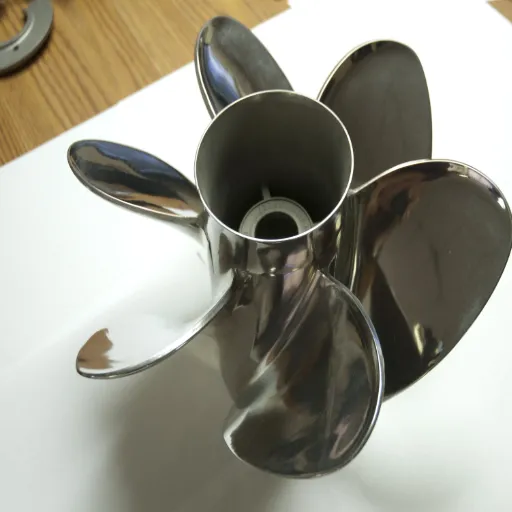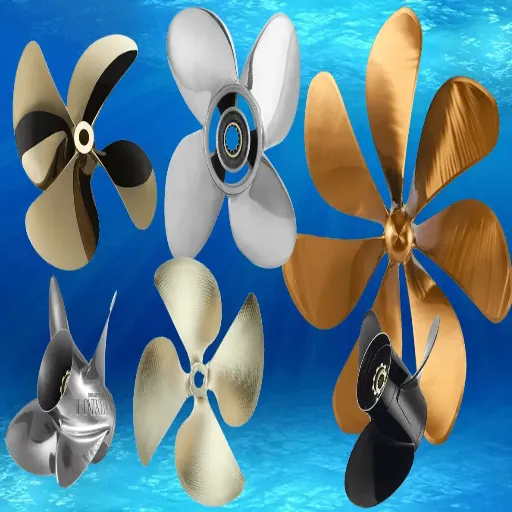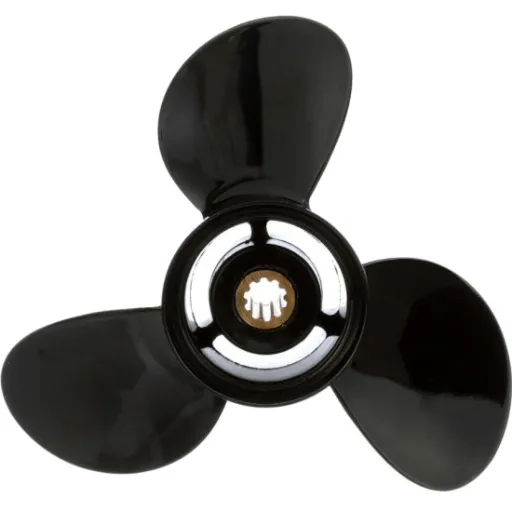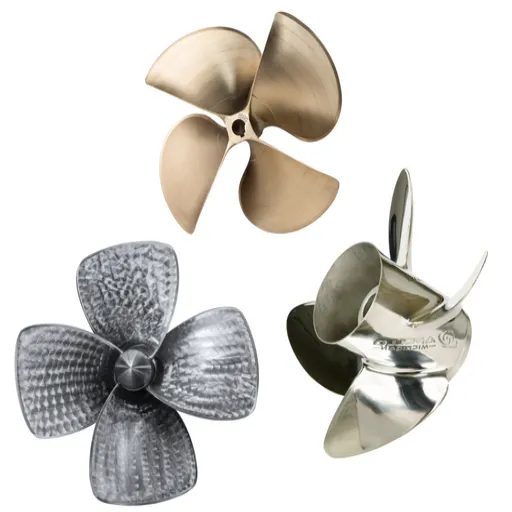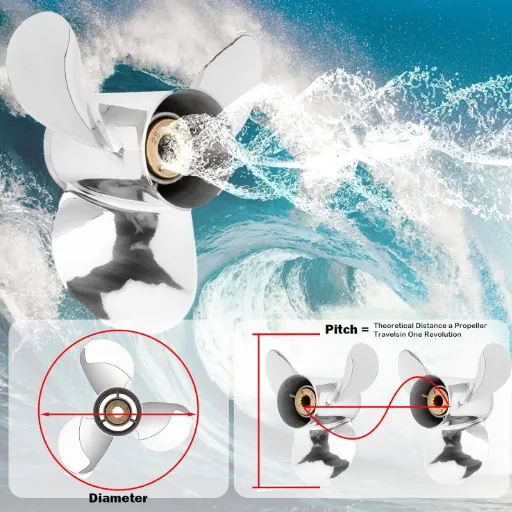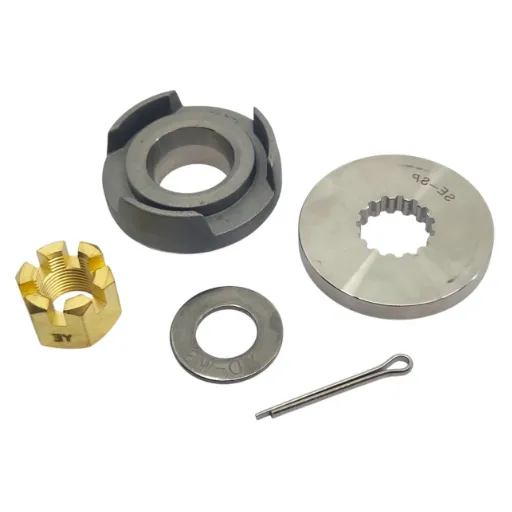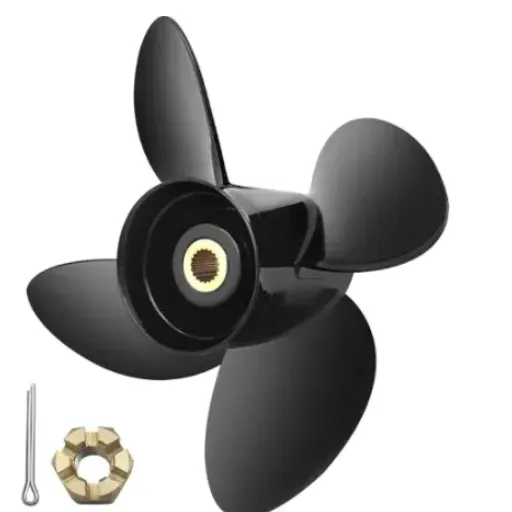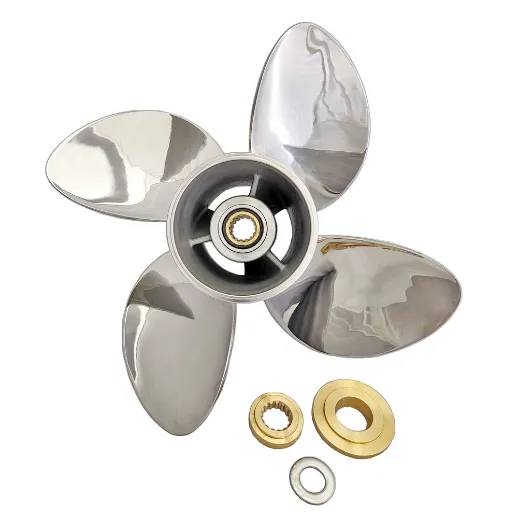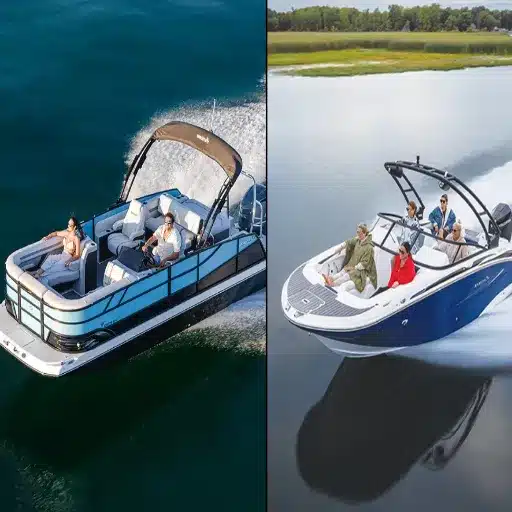Molding a full-blown revolution before 2025 in engineering, environmental regulations, and the increased demand for fuel-efficient technologies will undoubtedly be a very enticing aspect for the marine propeller manufacturing industry. This blog aims to highlight some of the most significant market trends expected to shape the competitive landscape, including increasing concerns for sustainable materials, hybrid propulsion, and innovative designs and production methods. Through a forecast-based approach to providing data-driven insights, the intention is to help manufacturers, suppliers, and other stakeholders adapt strategically to changing realities. Watch the curveball factors that will emerge in the forefront of marine propeller engineering while exploring the lineup measures on how businesses can remain resilient in this rapidly dynamic market environment.
Overview of Marine Propeller Manufacturers
Key Players in the Marine Propeller Market
A host of global manufacturers has led innovation and technological advancements in the marine propeller market. Thus, it leads the industry alongside other players, such as Rolls-Royce Holdings, Wärtsilä Corporation, and Hyundai Heavy Industries Co., Ltd., in providing propulsion solutions on the cutting edge. Rolls-Royce Holdings is renowned for its propulsion systems, which provide superior performance while considering efficiency and environmental impact. Similarly, Wärtsilä Corporation is a leader in utilizing advanced materials and ingenious designs to reduce fuel consumption and enhance reliability during operations.
| Company | Specialization | Key Innovations |
|---|---|---|
| Rolls-Royce Holdings | Advanced propulsion systems | Superior performance with environmental focus |
| Wärtsilä Corporation | Advanced materials & design | Fuel consumption reduction & operational reliability |
| Hyundai Heavy Industries | Shipbuilding & engineering | Powerful propellers for diverse vessel types |
| MAN Energy Solutions | Customized propeller systems | Tailored solutions for specific applications |
| Schottel Group | Hybrid propulsion technology | Energy-efficient hybrid systems |
As a significant industry player, the company leverages its shipbuilding and engineering expertise to design and build powerful propellers for a diverse range of vessel types. Other market players include MAN Energy Solutions and Schottel Group, with the former offering customized solutions for propeller systems and the latter providing hybrid propulsion technology. This set of manufacturers is working toward meeting the increased demand for energy-efficient designs while also addressing regulatory requirements for emissions.
The marine propeller industry’s competitiveness is characterized by continuous R&D activities from manufacturers, investment in innovative manufacturing processes, and collaborations that enable the development of broader product portfolios. For stakeholders who wish to analyze market dynamics and identify opportunities for growth, understanding the roles and contributions of key players is essential.
Trends Affecting Propeller Manufacture
🔬 Integration of Advanced Materials
The adoption of new materials, such as carbon fiber composites and titanium alloys, is changing the method of propeller manufacturing. These materials offer superior strength-to-weight ratios, corrosion resistance, and durability —all vital properties that increase propeller efficiency and reduce maintenance costs. For example, in recent times, advancements in composite technology have enabled lighter designs while maintaining a high level of structural integrity, resulting in lower operational expenditure.
🖨️ Additive Manufacturing
Additive manufacturing, or general 3D printing, is rapidly gaining traction in propeller fabrication due to its ability to create complex geometries with minimal material waste. Rapid prototyping and customization features are available in the setup, enabling manufacturers to tailor their designs to meet specific vessel requirements. Such short lead times have served as an impetus to the usage of this new technique in commercial and naval applications.
💻 Digital Twin Technology
Increasingly, digital twin technologies are being utilized to create virtual replicas of propellers, enabling the simulation and prediction of their performance under various operational conditions. By combining CFD-based simulation results with real-time feedback from performance tests, manufacturers can optimize their designs more effectively. This will enhance the efficiency and reliability of the design and help detect possible faults before they are realized.
🌱 Environmental Compliance
The world is witnessing increasingly stringent environmental frameworks, including those established by the IMO, which in turn is driving the advancement of eco-type propellers. The new ones aim to have ESD-equipped propellers, with their hydrodynamic performance highly optimized, to reduce fuel consumption and hence, greenhouse gas emissions. Hence, such innovations reinterpret the industry’s endeavor to fulfill decarbonization and sustainability targets.
🤖 Smart Manufacturing Processes
Savings in efficiency, time, and cost from automation and robotics with IoT connectivity are transforming the propeller manufacturing industry. Real-time monitoring and predictive maintenance of processes and machinery are implemented to maintain quality consistency while minimizing process time. This has ultimately led to increased efficiency, reduced downtime, and improved overall productivity.
⚙️ Customized Solutions for Niche Markets
The demand for customization in niche markets, such as luxury yachts and offshore vessels, has been exerting significant pressure on propeller manufacturing strategies. Manufacturers are prioritizing modular and adaptable designs that can address a range of operational requirements and ensure efficient performance across various marine sectors.
Industry Insight: Each of these trends highlights the dynamic and ever-changing nature of the marine propeller manufacturing industry, as it continues to evolve in response to the advancements in modern vessel performance, changing regulatory needs, and sustainability goals. Propeller manufacturers that manage to capitalize favorably on these technology trends shall, therefore, readily gain competitive advantages in the emerging complexities of the market.
Market Growth and Forecasts to 2025
The marine propeller market is expected to witness steady growth until 2025, with major driving factors including increased international trade, advancements in vessel construction materials, and demand for fuel-efficient and environmentally clean propulsion systems. It was reported in an industry magazine that growth would be approximately 4-5% compound annual growth rate (CAGR) during this time period and that the Asia-Pacific region was expected to dominate the market, garnering a significant share of global demand. This growth is inherently linked to the development and investment in commercial shipping fleets and naval defense.
Growth Drivers: Technological developments in the past few years, such as the integration of controllable pitch propellers, high-grade alloys, and novel coatings, are expected to provide further acceleration to market demand. Meanwhile, environmental laws, focusing on lowering emissions of carbon from maritime vessels, continue to be weighed upon the imposition of advanced propulsion technologies and the shaping of the market.
With dramatic opportunities being created on the rise of hybrid propulsion and electric-powered vessels as manufacturers turn their attention to integrating renewable energy into marine transport, the marine propeller market is expected to grow across further segments, including commercial shipping, fishing vessels, recreational boating, and defense, with innovation pace driving performance optimization and compliance continuously by the year 2025.
Advancements in Propeller Technology
Innovations in Precision Propeller Design
Precision propeller design and analysis mainly focus on aspects such as efficiency enhancement, environmental concerns, and better vessel dynamics. CFD simulations have recently become indispensable in propeller design, enabling engineers to examine and fine-tune blade geometries in conjunction with maximizing thrust and reducing cavitation. New-age materials, such as composites and lightweight alloys, are increasingly considered for minimizing weight without compromising structural strength, thereby increasing fuel economy and reducing operational costs.
Variable-Pitch Propellers: Furthermore, this variable-pitch propeller is considered an adaptive control system, where the vessel adjusts its blade angle depending on the load condition and operational requirements. Studies claim that VPP systems achieve further fuel savings of approximately 20% compared to fixed pitch. Noise reduction systems inventions are concerned with underwater radiated noise and involve optimized blade surface design and vibration-damping technology. This will be crucial for minimizing disruptions to marine ecosystems.
Furthermore, the integration of intelligent sensors and IoT (Internet of Things) platforms is revolutionizing propeller monitoring and maintenance. These systems provide real-time data for parameters such as vibration, torque, and blade condition, thereby promoting predictive maintenance and significantly extending operational life. Such advancements bear testimony to the importance that precision engineering and modern technology will have in the future of marine propulsion systems.
Cavitation Of Propeller Performance
Cavitation is a critical factor that affects the thrust, durability, and operational efficiency of marine propellers. Cavitation occurs when the pressure on the propeller blade drops, allowing water vapor to enter and form bubbles, which collapse violently as they drift into regions of higher pressure. This phenomenon can reduce thrust efficiency, produce extreme vibration, noise pollution, and physically damage propeller blades.
Impact Assessment: Studies show that damage caused by cavitation depends much on cavitation inception speed and blade shape. Cavitation consequently attacks those vessels that, due to high speeds, have poorly designed blades, as a tremendous pressure drop occurs near the blade surface. Uncontrolled cavitation, in fact, directly causes performance problems, such as thrust breakdowns or increased fuel consumption.
To control cavitation during propeller design, advanced hydrodynamic simulations and computational fluid dynamics (CFD) are employed. These allow the engineer to test different operating conditions for cavitation before actually manufacturing the propeller, and accordingly, make changes to blade profiles, surface finish, etc., to reduce pressure fluctuations. Other means of minimizing bubble formation and extending propeller life include the use of anti-cavitation coatings and adjusting the pitch of the blades.
Modern Solutions: Busy monitoring works with IoT platforms to enhance cavitation detection in real-time. This will, through an analysis of blade vibration and acoustic signals, alert ship operators to early signs of cavitation, allowing them to take corrective actions for optimal performance and minimal maintenance costs in the long run. Because engineering innovation is at the heart of solving the problems of cavitation in contemporary propeller systems, these developments are a test of that.
Emerging Technologies for Enhancement of Propulsion
Recent technological breakthroughs in propulsion systems are focused on enhancing performance and sustainability through the use of new materials, data analytics, and energy-efficient designs. One of the most significant breakthroughs is the application of advanced composite material technologies to propeller blades, such as carbon-fiber-reinforced polymers (CFRPs). These give the blades an unusually high strength-to-weight ratio and corrosion resistance, hence making them more durable and leading to lower fuel consumption.
🧠 Machine Learning Integration
Opposing this breakthrough in the monitoring procedure is the introduction of machine learning algorithms within the propulsion monitoring system. The algorithms analyze vast amounts of data collected from various operational conditions to schedule predictive maintenance and detect specific performance flaws before complete failure occurs.
🔋 Hybrid & Electric Systems
However, further look into hybrid and electric propulsion systems is underway in conjunction with the decarbonization drive. Advanced battery technologies, including LFP and solid-state batteries, allow for greater autonomy while maintaining high energy density.
♻️ Energy Recovery Systems
Energy recovery systems are also being developed, such as shaft generators and regenerative braking for marine and similarly heavy applications, which further support energy optimization.
Emerging technologies answer global needs for higher efficiency with a reduced environmental footprint. Their continuous development sustains not only operational advantages but also compliance with more burdensome international maritime regulations, such as the IMO greenhouse gas reduction strategy.
Custom vs. Commercial Propellers
⚙️ Benefits of Custom Propeller Solutions
Custom propeller solutions offer a wide range of benefits, from performance optimization to meeting regulatory requirements within the maritime sector. Regarding propulsion, custom propellers are designed with the intention of meeting the specific requirements of any vessel and hence offer greater propulsion efficiency. Once custom propellers are considered, blade geometry is tailored to the hull design, load conditions, and operational speed ranges, resulting in fuel savings that average 5 to 10% over non-customized options. This is usually the case; however, they still incur operational costs in terms of time and integration. This custom approach translates into direct monetary savings and a reduction in greenhouse emissions, thereby fostering the industry’s pro-sustainability stance.
Custom propellers minimize cavitation-induced vibration and noise, which can cause structural damage to both the propeller and the vessel. Through advanced hydrodynamic modeling techniques, such solutions grant smooth operation, long life, and excellent comfort onboard. Precise designs also help in complying with stringent noise emission standards, which are particularly important in environmentally sensitive locations and marine protected areas. The use of modern materials, such as nickel-aluminum bronze alloys, further strengthens the custom propeller with excellent durability and wear resistance, even under hostile marine environment conditions, thereby making it a trustworthy and future-ready vessel optimization option.
🏭 Commercial Propellers: Standardization and Performance
Being mass-produced and standardized, commercial propellers are manufactured to maintain consistency in performance, allowing them to be fitted on any of the multitude of vessels available on the market. To ensure that a standardized process is maintained, the process is carried out in accordance with international guidelines and regulations, such as ISO 484 or ITTC standards, which guarantee equal tolerances and dimensions. Implicitly, strict specifications maintain the performance of propellers under various applications, such as cargo ships, passenger ferries, and industrial support vessels, among others.
Performance optimization does not solely depend on blade geometry with pitch and skew, but also on intricate CFD analysis. It enables a designer to predict the hydrodynamic behavior and, therefore, engineer designs for maximum energy efficiency and cavitation reduction, among other factors. Modern commercial propellers typically exceed an operational efficiency of 70%, which is influenced by vessel type and operational regimes. With wear-resistant coatings and materials, such as duplex stainless steel, the propeller’s life is further enhanced while minimizing maintenance. Such an approach to standardization and tailored design exemplifies the industry’s commitment to achieving the highest efficiency and sustainability of maritime propulsion solutions.
Case Studies: Installation of Custom Propellers—A Success Story
📦 Enhanced Fuel Efficiency for Cargo Vessel
A major shipping company partnered with engineers to replace the standard propellers of one of its Panamax cargo vessels with custom-made ones, utilizing duplex stainless steel as the material. Optimized blade geometry reduced drag by 15%, resulting in a 12% fuel savings. Wear-resistant coating largely reduces cavitation damages and maintenance requirements, whereby the wear-resistant coating is forecast to increase the life by up to another 40%.
🛢️ Improved Maneuverability in Offshore Support Vessels
An offshore support vessel operating in dynamic and high-load environments underwent a custom propeller retrofit. The variable pitch blades were designed for thrust control under adverse weather and sea conditions. The vessel claimed a 30 percent increase in maneuverability while docking, shortening operating time and increasing safety margins. Efficiency enhancements were backed up by CFD simulations, which were further confirmed by performance monitoring onboard during installation trials.
🔇 Noise Reduction for Passenger Ferries
To comply with very restrictive noise pollution guidelines, passenger ferries would undergo upgrades, with propellers being custom-built to feature a highly skewed blade profile. Acoustic testing demonstrated a 40% reduction in underwater radiated noise, significantly improving environmental and noise standards and enhancing passenger comfort levels. At the same time, the vessels achieved about a 10% increase in overall propulsion efficiency due to reduced hydrodynamic losses.
Success Outcomes: These cases demonstrate how precision engineering, innovative materials, and tailor-made designs can lead to measurable improvements in performance across a wide range of maritime applications, thereby meeting operational goals while ensuring sustainability and compliance with regulations.
Impact of Boat Size on Propeller Selection
Choosing the Correct Prop for Different Sizes of Boat
Propeller choice is a highly complex process, considering factors such as size, weight, hull design, and application, which directly affect propulsion efficiency and vessel performance. Smaller boats such as dinghies or light fishing boats usually require propellers with smaller diameters and higher pitches. The primary speed inclination of this configuration is to favor speed and offers the best performance for vessels with low power-to-weight ratios.
🚤 Small Boats
Dinghies and light fishing boats require smaller diameter propellers with higher pitches, favoring speed and optimal performance for vessels with low power-to-weight ratios.
⛵ Medium Boats
Cabin cruisers and water sports crafts need medium-diameter propellers with moderate pitches, striking a balance between acceleration and fuel efficiency using aluminum or composite materials.
🛥️ Large Vessels
Yachts and commercial boats require high-thrust propellers with greater diameter and lower pitch, typically made of stainless steel or strong alloys for durability under heavy-duty conditions.
A middle-ground approach is required for medium-sized boats, such as cabin cruisers or water sports crafts. These medium-diameter propellers, which handle moderate pitches and blade counts, strike a balance between acceleration and fuel efficiency to meet diverse performance requirements. Such boats typically feature aluminum- or composite-material propellers, which reduce weight and enhance responsiveness.
Due to their heavier draft and larger size, vessels such as yachts or commercial boats require high-thrust propellers with greater diameter and lower pitch to move the mass efficiently. Such props are typically made of stainless steel or other strong alloys, allowing them to withstand further stress while maintaining their durability over time. The number of blades and other advanced geometrical designs, such as cupping or skew, are useful in minimizing cavitation and increasing load-carrying capacity during heavy-duty operating conditions.
Selection Process: Thus is how propeller selection ought to proceed based on accurate calculations of factors such as the maximum RPM of the engine, the desired cruising speed, and the load-carrying capacity. Continuous optimization of propeller performance relative to the vessel’s exact requirements through regular monitoring and adjustments, combined with advances in hydrodynamic modeling and material improvements, would result in safe, reliable, and efficient vessel operations that meet today’s demands.
Performance Characteristics of Various Types of Boats
Key Performance Indicators by Vessel Type
The performance characteristics of different types of boats are primarily determined by hull design, propulsion systems, and load configurations, which are influenced by their operational requirements. Thus, the speedboat with planing-hull features may concern speed and power, fuel consumption at different rates, speed at the higher-end (knots), and acceleration profiles. Displacement hull boats, on the other hand, are analysed in greater detail for endurance range and coefficients of wave resistance, to remain stable and carry loads efficiently at a lower speed.
Recent developments in computational fluid dynamics, telemetry, and real-time data collection allow for exact measurements and monitoring of these performance metrics. For instance, a ship might be equipped with high-resolution sensors that continuously record variables such as thrust output, propeller slip, and fuel burn efficiency, all under various operating conditions. Armed with such data, marine engineers can then improve vessel design and coordinate with propulsion systems to meet the varying needs of commercial, recreational, or military applications in the field.
Data-Driven Optimization: In addition, using modern data visualization methods for comparative analysis of cross-segment performance provides a more intuitive means to identify inefficiencies and foresee corrective adjustments, as long-term wear and energy loss are expected to occur. These metrics will become more valuable as sustainability-based innovation in marine technology receives a boost, with the integration of renewable energy, such as unforecasted tubing hybrid-electric propellers, being exemplary cases that have had to retain operational efficacy.
Future Trends in Boat Size and Propeller Compatibility
The advancements in marine engineering are bringing forth significant changes with respect to boat size and propeller compatibility, in accordance with her sustainability needs, efficiencies, and performance in response to ever-shifting demand profiles. Meanwhile, the larger vessels are increasingly in vogue, featuring greater cargo-carrying or passenger capacity and reduced operational costs per unit. This presage is worthy of being developed. A thrust worthy of consideration includes that of a propulsion system that can provide a thrust level adequate and efficiently so for extended tonnages without inducing higher fuel consumption and environmental side effects.
Propeller compatibility is evolving rapidly to meet these requirements. With the evolution of larger ships, designers are now developing propellers using new materials, including composite alloys and carbon-fiber composites, which impart strength, resist corrosion, and present good hydrodynamic characteristics. Adjustable pitch propellers and modular systems are also widely accepted, allowing for flexibility in varied performances depending on operating conditions.
Today, CFD modeling offers a considerable means to improve the design of propellers further, considering the sizes of the vessels, thereby warranting the highest efficiency. For example, innovative blade forms and variable diameter systems are being developed to mitigate cavitation and noise, which are crucial for sustainable maritime operations and passenger comfort.
Electric Propulsion Impact: Hybrid and fully electric propulsion systems stand in stark opposition to the continued consideration and standardization of propeller types. An essential characteristic of electric propulsion is the high torque at low rpm, which enables the manufacturing of large-diameter, slow-turning propellers that produce more thrust and better energy efficiency. Hence, the integration and coordination of these design factors must occur at every vessel design stage, starting with size, weight distribution, and propulsor dynamics.
Roughly, trends forecast the future interdependence of vessel and propeller designs, whose design parameters shift between state-of-the-art materials, simulation technologies, and energy-efficient propulsion systems to meet evolving industry requirements.
Marine Hardware and Accessories for Propellers
Zinc Anodes and Propeller Longevity
The zinc anodes serve as a protective feature, asserting the longevity of propeller systems by combating the effects of galvanic corrosion. The metal parts immersed in water, such as the propellers, undergo electrochemical reactions with dissimilar metals. This reaction accelerates corrosion, compromising the structural integrity of the propeller and its long-term efficiency. Therefore, by introducing zinc with anodes that act as sacrificial ones, the reactants prefer to take part in the reaction with the zinc metal instead of the propeller. This keeps the propeller free and in proper working condition, thereby lowering the possibility of heavy maintenance or replacement.
Maintenance Critical: In my opinion, zinc anodes are an essential component of preventive maintenance for marine systems. If not installed correctly and replaced at the correct time, the anodes cannot work to their full capacity. A zinc anode, once worn out, ceases to protect and subjects the propeller to intensified corrosion unless it is regularly checked. I have always found that something as simple as regularly assessing the thickness of the anodes and making sure they are fitted correctly onto the propeller hub is crucial in maximizing the service life of a marine propulsion system.
Along with these factors and the use of zinc anodes considered in the overall operational efficiency and sustainable concept of marine technology, the anodes prevent severe corrosion; therefore, they protect the hardware and promote fuel efficiency by allowing propellers to operate free from structural flaws or resistance. This further emphasizes the need for high-quality anodes and proper maintenance of these anodes, ultimately enhancing the reliability and performance of marine vessels.
Understanding Inboard Propellers and Their Applications
Several types of propellers are found onboard boats, but the types discussed above, inboard propellers, are the most common. Inboard propellers are located under the hull, connected to the engine through the shaft, and thus drive the boat forward or backward. Design-wise and location-wise, these propellers minimize drag, thereby allowing for good water flow. Based on my experience, inboard propellers are primarily used on larger vessels, such as yachts, commercial vessels, and fishing boats, where long-term reliability is a key factor.
Above and beyond mere propulsion, inboard propellers find their application in durability, particularly in challenging marine environments that require resistance to cavitation and biofouling, which can otherwise deteriorate performance over time. Being located underneath the hull provides great stability and weight distribution, which is another reason why inboard propellers are required during operations that require precise maneuvering and control. I personally see the merit of their performance when towing or for vessels that need fixed speed and power under strenuous conditions.
Professional Insight: Altogether, inboard propellers are crucial to marine operations, providing sturdy and versatile solutions for various marine applications. Using high-grade materials along with good maintenance and proper alignment of the casing with the engine of the vessel can enhance the propeller performance and increase its life, keeping in mind that, from my point of view, well-grounded knowledge of its working principle and application is required of anyone engaged in the working of marine vessels or their designing or servicing.
Bearings and Shaft Components that are Essential for Best Performance
Hence, in achieving maximum performance, my experience has dictated that one must delve into the details of marine propulsion-system shaft bearings and components. Bearings, such as thrust bearings and plain journal bearings, support the rotating shaft while accepting both axial and radial loads. Thus, the proper selection and maintenance of these components directly affect the system’s efficiency. Some consider that thrust bearings meet the axial forces that develop from the ship’s propulsion; hence, mechanical stress would compromise the reliability of the whole drivetrain without such bearings.
Intermediate and propeller shafts, as well as shaft components, are equally essential for transmitting mechanical power from the engines to the propellers. Proper shaft alignment is crucial, as even slight misalignments can cause vibration, energy wastage, and premature component failure. Furthermore, the degradation of materials in an aggressive marine environment can only be prevented through the use of advanced materials, such as corrosion-resistant alloys or composite materials. On the other hand, regular inspection and proper lubrication ensure the long service life of these components.
Modern Monitoring: On a technical level, investing in modern condition monitoring technologies, such as vibration analysis and thermographic imaging, would provide valuable real-time insight into the condition of bearings and shafts. Marine engineers would then be able to tackle any problems before they develop into expensive failures. Once selected, maintained, and monitored on a condition-based basis, bearings and shafting components would ensure that the marine propulsion system is capable of long-term, reliable operation.
Reference Sources
-
Marine Propellers Market – Industry Analysis (2025-2032)
This report provides insights into the market valuation, growth rate, and key trends shaping the marine propeller industry. -
Marine Propeller Market Size, Share & Growth | Forecast
A detailed analysis of the global marine propeller market, including projected growth and technological advancements. -
Marine Propeller Industry 2025 Trends and Forecasts 2033
This source highlights the robust growth and future trends in the marine propeller industry. -
Marine Propeller Market to Grow at a CAGR of 8.3% by 2032
A press release discussing market growth projections and key factors influencing the industry. -
Marine Propeller Plug Market Share Analysis 2025 – 2033
Focuses on a niche segment within the marine propeller market, providing additional context on market dynamics. - Click here to read more.
Frequently Asked Questions (FAQs)
❓ What is considered to be the key factor in the design of marine propellers?
The design of a marine propeller considers several key factors, including blade shape, pitch, diameter, and material. Technology and CNC machining are often used in the design of high-performance propellers, enabling them to be very precise and maximize efficiency in performance. The manufacturer will also consider the operating conditions of the vessel, such as speed and vibration, to ensure optimal performance. Brands such as Michigan Wheel and Acme represent cutting-edge design for both pleasure and inboard racing. Aluminum or stainless steel, on the other hand, would make a difference in durability and performance, depending on the application.
🛥️ How to select a propeller for my boat?
Selecting the right boat propeller involves considering the engine specifications of the vessel, its intended use, and the performance requirements. Several factors, including the boat’s weight, the type of engine, and the desired speed, will influence the decision. One should approach the manufacturers or distributors to get a better understanding of what best suits their needs and options. Performance propellers are designed to maximize speed and fuel efficiency, while the inboard propeller may differ slightly in design and capacity from the outboard. Be sure to thoroughly study the brands and what they offer, so you can make an informed decision.
⚡ What role do cavitation play in the Marine Propeller Performance?
Initially, secondary phenomena occur; however, as the effects become more serious on pump performance, causing the loss of efficiency, increased vibrations, and ultimately failures. Cavitation takes place when the pressure on one side of a propeller blade falls below the vapor pressure of water. Keep in mind that the higher the pressure against which a propeller works, the more violent the cavitation. Therefore, there are several reasons why dealers might want to install propellers with notably designed cavitation characteristics, shaped optimally with respect to blade shape and pitch. Castration of propellers must be understood by engineers and any other workers in the field of the design and manufacture of propellers as relevant to the impacts on the durability and utilities of propellers in various marine service applications.
🔧 What kinds of materials do marine hardware, such as propellers, use?
Making marine hardware, such as propellers, from durable materials like stainless steel, aluminum, or composites is quite common. Stainless steel boat props are strong and corrosion-resistant, making them excellent for use in both saltwater and freshwater environments. Aluminum propellers, on the other hand, are lighter and less costly but may be less durable. Brands try different materials and coatings in an attempt to increase performance and efficiency. Even the material itself can contribute to the overall weight of a prop, which is crucial for the vessel’s optimal performance.
✅ How does a marine propeller distributor ensure quality?
A marine propeller distributor would only check for quality with recognized manufacturers, well known for their adherence to quality standards in propeller design and manufacturing. They typically carry an array of performance propellers that have undergone various tests for durability and performance. The distributors might also offer features such as warranties and customer support to support the quality of the items they sell. Keeping themselves updated with new technology and trends in the marine sector also helps these distributors to offer avant-garde options to their clientele. The ideology of quality ensures that the boat owner gets the best performance from their vessel.
🚀 What progress is occurring in the field of boat-propeller-making?
Contemporary propeller technology holds the scope for improvements in terms of thrust, efficiency, and durability. Innovations like the Sharrow propeller design have revolutionized the concept of maximizing thrust while minimizing drag and fuel consumption. Increasingly, manufacturers are employing CNC machining techniques and high-grade advanced materials for manufacturing their effective designs. Furthermore, technologies such as computer simulations and testing have enabled deeper insight and optimization in propeller performance. From the application side, these innovations enhance the effectiveness of recreational and commercial marine vessel usage.




